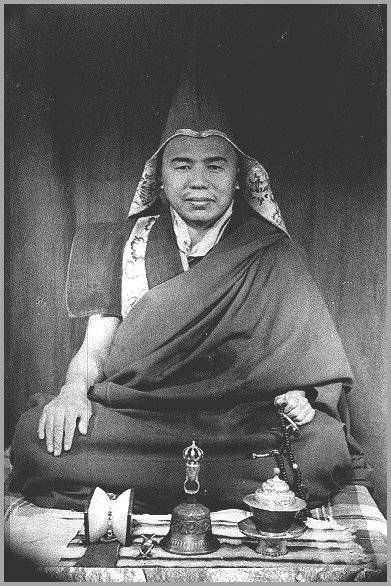Difference between revisions of "User:Rangjung"
| Line 1: | Line 1: | ||
| − | [[Image:Tulku_Urgyen_Rinpoche.jpg]] | + | [[Image:Tulku_Urgyen_Rinpoche.jpg|frame|Tulku Urgyen Rinpoche - Tsewang Chokdrub Palbar (1920-1996)]]'''Tulku Urgyen Rinpoche''' 1920-1996 (sprul sku o rgyan rin po che). A contemporary Buddhist master of the [[Kagyü]] and [[Nyingma]] lineages, who lived at [[Nagi Gompa]] hermitage in Nepal. His main transmissions were the [[Chokling Tersar]] and the [[pointing-out instruction]]. |
Tulku Urgyen Rinpoche was born in eastern Tibet on the tenth day of the fourth Tibetan month in 1920 and passed away in Nepal on February 13, 1996. [[Khakyab Dorje]], the 15th [[Gyalwang Karmapa]] recognized him, as an incarnate lama. He studied and practiced the teachings of both the Kagyu and Nyingma orders of Tibetan Buddhism. | Tulku Urgyen Rinpoche was born in eastern Tibet on the tenth day of the fourth Tibetan month in 1920 and passed away in Nepal on February 13, 1996. [[Khakyab Dorje]], the 15th [[Gyalwang Karmapa]] recognized him, as an incarnate lama. He studied and practiced the teachings of both the Kagyu and Nyingma orders of Tibetan Buddhism. | ||
In the Nyingma tradition, Tulku Urgyen held the complete teachings of the last century’s three great masters: [[Terchen Chokgyur Lingpa]], [[Jamyang Khyentse Wangpo]] and [[Kongtrul Lodro Thaye]]. He had an especially close transmission for the [[Chokling Tersar]], a compilation of all the empowerments, textual authorizations and oral instructions of [[Padmasambhava]]’s teachings, which were rediscovered by Terchen Chokgyur Lingpa, his great-grandfather. | In the Nyingma tradition, Tulku Urgyen held the complete teachings of the last century’s three great masters: [[Terchen Chokgyur Lingpa]], [[Jamyang Khyentse Wangpo]] and [[Kongtrul Lodro Thaye]]. He had an especially close transmission for the [[Chokling Tersar]], a compilation of all the empowerments, textual authorizations and oral instructions of [[Padmasambhava]]’s teachings, which were rediscovered by Terchen Chokgyur Lingpa, his great-grandfather. | ||
Revision as of 04:57, 12 December 2005
Tulku Urgyen Rinpoche 1920-1996 (sprul sku o rgyan rin po che). A contemporary Buddhist master of the Kagyü and Nyingma lineages, who lived at Nagi Gompa hermitage in Nepal. His main transmissions were the Chokling Tersar and the pointing-out instruction.
Tulku Urgyen Rinpoche was born in eastern Tibet on the tenth day of the fourth Tibetan month in 1920 and passed away in Nepal on February 13, 1996. Khakyab Dorje, the 15th Gyalwang Karmapa recognized him, as an incarnate lama. He studied and practiced the teachings of both the Kagyu and Nyingma orders of Tibetan Buddhism. In the Nyingma tradition, Tulku Urgyen held the complete teachings of the last century’s three great masters: Terchen Chokgyur Lingpa, Jamyang Khyentse Wangpo and Kongtrul Lodro Thaye. He had an especially close transmission for the Chokling Tersar, a compilation of all the empowerments, textual authorizations and oral instructions of Padmasambhava’s teachings, which were rediscovered by Terchen Chokgyur Lingpa, his great-grandfather. Tulku Urgyen established several monasteries and retreat centers in Nepal. The most important ones in the Kathmandu region are at Boudhanath, the site of the Great Stupa, at the Asura Cave, where Padmasambhava manifested the Mahamudra Vidyadhara level and at the Swayambhunath stupa. He primarily lived at the Nagi Gompa Hermitage above the Kathmandu Valley. He is the father of tulku sons, Chokyi Nyima Rinpoche, Tsikey Chokling Rinpoche, Drubwang Tsoknyi Rinpoche and Yongey Mingyur Rinpoche. Rinpoche instructed a growing number of Dharma students in essential meditation practice. He was famed for his profound meditative realization and for the concise, lucid and humorous style with which he imparted the essence of the Buddhist teachings. His method of teaching was 'instruction through one’s own experience.' Using few words, this way of teaching pointed out the nature of mind, revealing a natural simplicity of wakefulness that enabled the student to actually touch the heart of awakened mind.
External Links[edit]
References[edit]
Tulku Urgyen Rinpoche. Vajra Speech. Translated by Erik Pema Kunsang. Boudhanath: Rangjung Yeshe Publications, 2001.
